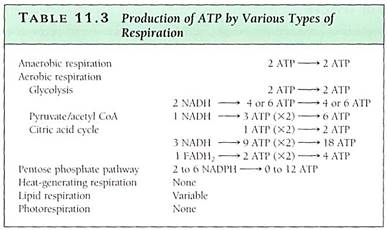
Total Energy Yield of Respiration
 المؤلف:
AN INTRODUCTION TO PLANT BIOLOGY-1998
المؤلف:
AN INTRODUCTION TO PLANT BIOLOGY-1998
 المصدر:
JAMES D. MAUSETH
المصدر:
JAMES D. MAUSETH
 الجزء والصفحة:
الجزء والصفحة:
 2-11-2016
2-11-2016
 2417
2417
Total Energy Yield of Respiration in Plants
During anaerobic glycolysis, four molecules of ATP are synthesized, while either one or two ATPs must be used to initiate the process, depending on whether glucose or glucoses-phosphate is the initial substrate. The NADH+ H+ generated cannot be used for energy, so the net result is two molecules of ATP for every molecule of glucose fermented (Table 11.3).

During aerobic respiration, glycolysis again yields two ATPs directly; in addition, the two NADHs can be transported to mitochondria, where their electrons power the formation of two or three more ATPs. The conversion of each pyruvate to acetyl CoA yields another NADH. Because two pyruvates are produced from each initial glucose, six more ATP per glucose are produced. Within the citric acid cycle, each original molecule of glucose yields two molecules of ATP, six of NADH, and two of FADH2; the total is 24 ATPs Aerobic respiration can produce as many as 38 molecules of ATP, making it significantly more efficient than anaerobic respiration.
The pentose phosphate pathway yields only two NADPH per glucose-6-phosphate if either ribulose-5-phosphate or erythrose-4-phosphate is drawn off for anabolic metabolism. If neither of these is removed, the various intermediates continue to cycle until al carbon of the glucose is completely oxidized to carbon dioxide and six NADPHs are produced. These may be used for cellular reductions of nitrate to amino acids, sulfates to sulfhydryls, or carbohydrates to fats. NADPH not consumed in anabolic reductions nay contribute protons to the mitochondrial electron transport chain and indirectly produce two molecules of ATP.
The amount of ATP produced by fatty acid respiration depends on the length of the fatty acid and whether acetyl CoA enters the citric acid cycle; with maximum respiration, up to 40% of the total energy in a fatty acid is conserved in ATP. Thermogenic respiration and photorespiration produce no ATP. Also, keep in mind that intermediates may be diverted from all respiratory pathways and be used in synthetic reactions, so compete respiration may not occur; ATP production thus is less.
 الاكثر قراءة في مواضيع عامة في علم النبات
الاكثر قراءة في مواضيع عامة في علم النبات
 اخر الاخبار
اخر الاخبار
اخبار العتبة العباسية المقدسة


